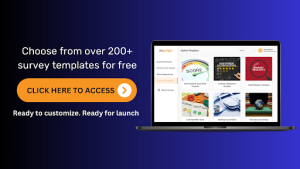Customer feedback surveys are the most critical part of an organisation. It bridges the gap between a customer’s needs and an organisation’s offerings. In this blog, we will discuss why customer feedback is necessary for a business. The blog also contains a short guide on how to create highly responsive customer feedback surveys.
Customer feedback surveys focus on one aspect- high response rate
Most customer feedback campaigns use traditional mediums to stay connected with their consumer base. This creates a barrier in a digital world. People are connected via other fast-paced and in-moment platforms. External browser based links or slow email channels can sometimes hamper your survey response rate. A survey needs a good response rate to be able to draw a reasonable conclusion.
Survey Response Rate Calculation Formula
You can use the following formula to calculate the survey response rate.
Response rate = (number of respondents who completed the survey / total number of people who received the survey) x 100
This will give you your response rate as a percentage.
Example: you sent the questionnaire to 50 people and 20 respondents completed it. The total is 40% response rate.
What is considered a good response rate in surveys?
There are many factors to consider. This also depends on the type of industry and the format of the questionnaire. Typically, the ranges seem to fall between 20% to 30%. A survey response rate below 10% is too low to form a reasonable conclusion. A rate of 50% and above is considered good.
However, keep in mind that response rate is different from completion rate. This can affect the survey goal and overall response rate metrics. To get a good survey response rate (with a 100% completion rate), share the questionnaire among a wider set of respondents.
A good survey response rate can vary widely depending on the type of survey, the audience, and the method of distribution. Here are some general guidelines:
Internal surveys (within an organization):
High response rate: 70% or higher
Average response rate: 50-60%
Low response rate: Below 50%
External surveys (customer or public surveys):
High response rate: 20-30%
Average response rate: 10-20%
Low response rate: Below 10%
Email surveys:
High response rate: 20-30%
Average response rate: 10-15%
Low response rate: Below 10%
Why Is Customer Feedback Important for CX?
Customer feedback dictates how a business can operate in the best interest of its consumer base. Here are some of the reasons:
1. Filter through responses on customer satisfaction metrics:
Customer feedback offers direct insights into their needs, wants, preferences of the market i.e your direct consumers. Using this information, companies can identify areas of improvement for their products and services. It is imperative to improve on current business offerings to stay in tandem with market demands.
2. Gather data on pain points at various touch points:
Unattended pain points can damage a brand’s market reputation. User response forms can prevent early mishaps, close feedback loops and convert a detractor to a brand ambassador. Capturing high friction points can also prevent high churn rates at different points of the customer journey.
3. Prevent any churn rates before it’s too late:
Customer acquisition costs way more than retaining your brand advocates. According to data by Zendesk, a massive 66% of people discontinued their relationship with a brand due to poor customer service. Churn rate is when customers leave a company due to multiple negative experiences. This can include poor customer service, no requirement of the product, high pricing, ineffective marketing, no product upgrades or better offers from competitors.
4. Close feedback loop with unhappy respondents:
People love a transparent brand. People might willingly offer reviews on third party review apps or on Google reviews. Surveys must offer a qualitative and quantitative format of questions to understand their user base better. Apple used their net promoter score survey to reach out to detractors and close the feedback loop. In return, this exercise gained them $25 million additional revenue.

5. Provide consistent customer experience:
The key to high retention rate is consistent CX. Surveys are a great tool to identify service gaps, pain points, and communication leaks across customer touchpoints. People offer candid opinions on their experiences which can help companies improve their response times during customer service.
6. Drive innovation with data-driven marketing:
The market is a dynamic place. Companies need to offer people a platform to voice their concerns and needs. This can help brands upsell, cross their products, improve offerings and make amends during friction points. Data driven survey figures can create better marketing strategies for business.
Get Maximum Responses Rate: 7 Best Practices
Here are the best practices to opt for, when curating a questionnaire that will reap a high response rate.
1. Cut down on questions you do not need:
A long questionnaire can have a high abandonment rate, a high survey dropout rate or biased answers. Respondents have one motive- to finish it as soon as they can, irrespective of the data quality. This hampers the way we conduct our market research. Aggressively cut down on questions that are not immediately important. Focus on the main goal of the survey and the expected outcome.
2. A conversational tone is friendly over an intimidating tone:
A pre designed survey template can save marketers from the hassle of creating questionnaires from scratch. The Merren templates are pre-tested and are conversational in tone. When surveys adopt a friendly tone, you can expect a high response rate. People are more willing to respond to a friendly over a formal format of questions (it seems intimidating or demanding).
3. Incentivize respondents with survey rewards on completion:
Survey rewards are a good way to increase the response percentage of a customer feedback form. Keep the reward systems relevant to the audience. It can be in the form of coupons or vouchers, cashbacks or complementary products along with their purchases. Using Merren, organisations can now share rewards and incentives upon completing a questionnaire. However, this facility is now only available for the enterprise plans.
4. Use standard customer satisfaction metrics to gauge satisfaction levels:
Customer satisfaction metrics such as net promoter score (NPS) and customer satisfaction surveys (CSAT scores) and customer effort score (CES) are the gold standard to capture responses on experiences.Most of these metrics have one qualitative and one quantitative question. Shorter questions can bring a high response rate on your CX dashboard. These industry benchmarks are indispensable while obtaining crucial user data.
5. Don’t wait too long for a customer’s feedback:
In-the-moment feedback means seeking responses from your customers immediately after an experience or a transaction. Post purchase surveys have the potential to bring a high survey response rate since. It is deployed immediately after a financial transaction. Marketers can make the best of communication protocols when they seek real time feedback to enhance the overall customer experience (CX).
6. Use multilingual surveys to make your questions, relatable :
While curating questions, we cannot assume that english will be the globally accepted language of conversation. Avoiding multilingual features means leaving our potential responses from a diverse demographic. Merren can automatically translate surveys with a click of a button. Our platform supports 100+ languages for a customer feedback survey. While people would love to answer forms in their local language, they can provide a more genuine, yet authentic response.
7. Capture a customer’s opinions at all major touchpoints
A great way to ace long-term customer retention is to diligently capture feedback across the customer mapping journey. This way, even when you onboard potential buyers, you can understand their behaviours, preferences, background and expectations. This makes it easier for organisations to curate better marketing strategies for their buyers. This is a good way to build a strong foundation of patrons. One way to do this is to choose the right customer journey mapping tool for your business.
Use the best survey distribution channels:
Traditional mediums of survey did not bring much results in terms of response rate. Our customers are moving to the digital platform. This will leave our potential customers when we do not get along with modern technology. Fret not. Here are the channels that can help marketers get a high response rate in their surveys.
1. WhatsApp forms and Facebook messenger surveys:
WhatsApp messenger surveys and Facebook messenger exchange billions of messages on a daily basis. The USA is witnessing the double digit use of WhatsApp as reported by Meta. Messenger applications are highly interactive, compatible across devices and accessible by most people globally. It makes perfect sense to share a survey via Facebook messenger or WhatsApp.
2. Dynamic emails for in-moment surveys:
AMP translates to accelerated mobile pages. AMP email was created so that people could participate inside the email body without moving to an external browser. The emails can be interactive and compatible across devices. Dynamic email surveys allow customers to answer feedback questions right from their inbox- via their phones or on a computer.
3. Chatbots as driven by artificial intelligence:
Chatbots are highly efficient tools that run around the clock. This is mostly used where human intervention is not feasible or the business runs on a 24 hour clock. An AI powered chatbot can collect complex customer data. It can function independently and offer faster answers to commonly answered questions. A chatbot can capture emotional metrics and offer fast suggestions without manual intervention.
Conclusion
A customer feedback survey is important for business for multiple reasons. It can capture pain points, reduce churn rates, understand customer needs and offer transparent communication. To 10x your survey response rate, you need to follow the best practices. This includes making forms in conversational tone, using market standard satisfaction metrics and opting for survey rewards. If you want to create a WhatsApp survey, sign up for a 14 day free trial without any credit card details.



